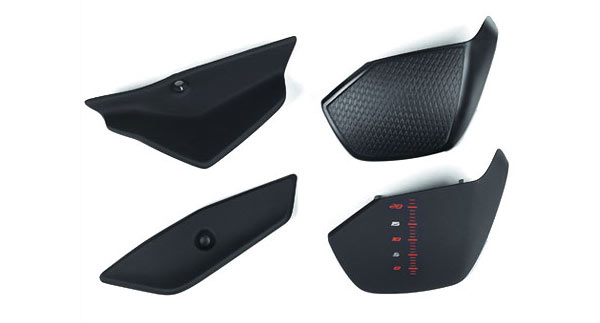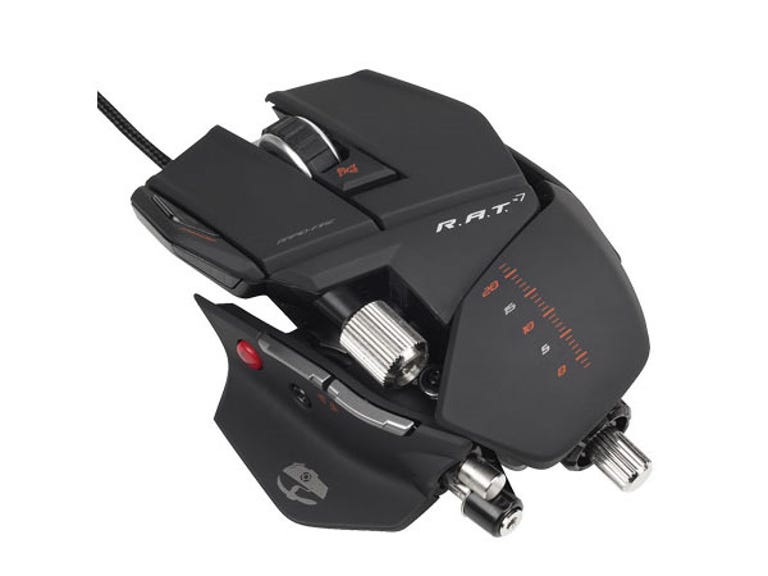 Why You Can Trust CNET
Why You Can Trust CNET Cyborg R.A.T. 7 review: Cyborg R.A.T. 7
Cyborg's R.A.T. 7 is craziness embodied, and we love it. Customisable to the teeth, it's only let down by a slightly unpolished software suite. It is an otherwise fantastic mouse; its unique features ensuring that it earns our Editors' Choice award.
It's fair to say that the Cyborg R.A.T. 7 is a little bit nuts.
The Good
The Bad
The Bottom Line
Customisation is the name of the game in gaming mice, but rarely to this degree. While the occasional vendor tosses in weight adjustment or swappable grips, the custom stuff is mostly left up to the software.
Not so the R.A.T. 7, which, before even getting to the software, has decided that the whole mouse needs to be adjusted before play begins proper.
Yes, it's got weights — five discs of 6g each — but it's also got three swappable palm rests, one that's covered with the in-vogue rubberised plastic, one that's the same but 4mm higher, and another that's cross-etched to provide extra grip. Each one of these grips has a lever that can be depressed, allowing it to slide back and forth into four lockable positions, attempting to compensate for the variance in personal grip and hand length.
But we're not finished yet. See that silver knob at the base? Unscrew it and it becomes a hex tool, used for further adjustment of the mouse.
The thumb rest on the left is anchored at the base near the palm grip, and can be pulled away from the mouse near the left- and right-click buttons to minimise the effort your thumb needs to actuate the buttons. This same thumb rest can be slid back and forth so the buttons rest perfectly where you need them to. When you're done, you lock them into place with the hex tool. It's marvellous, although the back and forward buttons are still a stretch too far for us, and we'd prefer to swap them for the horizontal scroll wheel, which is situated between the thumb rest and the body of the mouse.
The pinky rest is also swappable, offering rubberised plastic, cross-etched grip or a "wing"-shaped design that supposedly allows your pinky to rest during long bouts of play — we found quite the opposite, the shape propping our pinky into an unnatural position.

Swappable parts. A gaming enthusiast's heaven. (Credit: Cyborg)
The buttons themselves have a wonderfully solid click, the scroll wheels thunk satisfyingly between detents (although the horizontal scroll is awkward to reach), and the DPI switcher while not perfectly placed is reachable, with four lights on the left-hand side lighting up to denote what DPI the mouse is currently set at. These levels can be customised in the software, with x and y axes able to be set independently.
Setting the DPI for each mode. (Screenshot by Craig Simms/CNET Australia)
This is all fairly standard, but what isn't is the precision aim mode, something infinitely more usable than on the fly DPI switching: hold down the red button on the thumb rest and the DPI drops to a custom level, allowing you to pop off a more accurate sniper round. Release the button and the DPI returns to normal. Simple, and genius.
The precision aim mode is wonderful, and can be enabled by holding down the red button. (Credit: Cyborg)
Cyborg's software certainly doesn't look as polished as its competitors from the likes of Razer, Roccat and SteelSeries, but it does the job. The standards are here, like customising buttons and being able to save multiple profiles. Within each profile you can store three different modes, each one allowing the user to set up different customised buttons. You can switch between modes through a button to the left of the left mouse button.
This level of customisation means that saving profiles on the mouse is a little difficult, with Cyborg instead opting to go with the old-school method of storing them on the hard drive.
Button customisation is also significantly more confusing and frustrating than it needs to be. A serious redesign is required, focused on minimising clicks and making the terminology used more accessible. Even the manual struggles to make concepts clear, using inconsistent terms.
Cyborg's button customisation software certainly isn't as elegant as Razer's or Steelseries'. (Screenshot by Craig Simms/CNET Australia)
This is partly due to the fact that the R.A.T. offers so many features; for instance it has a "latched" mode, where pressing a button acts like a toggle. Say you've bound the mouse button to the CTRL key. If it has been set as "latched", the computer will act as if you're continuously holding down CTRL. Press the button again, and it'll think you've released. Great for games without a crouch toggle control.
There's also a fallback mode — if a button is set to this while the mouse is in mode two or three, it refers back to whatever the button was set to in mode one. Don't like any customisations? Set the button to Unprogrammed.
Then there are Keypresses and Macros — the latter is the macro we all know and love. Record keyboard presses and mouse clicks, assign them to a button, then click to play back the action. Where Keypresses differ is if you hold down the button, the programmed entry will play out up to the point where you release your mouse button, offering the ability to quickly change course should something unpredictable happen. We'd advise always going with the "Advanced Command" dialog, as it offers considerably more space to see your recorded effort than the default Keypresses or Macro options.
While entering delays is an utter pain due to having to select multiple key entries rather than setting insertion points the option is there, as is the ability to set a standard delay between all key strokes.
Playtesting in Serious Sam: HD and Left 4 Dead revealed the Cyborg R.A.T. 7 to be excellent, both in accuracy and thanks to its very handy precision aim mode. Our Logitech G500 is currently kitted out with 19.7g of weights, but we found adding more weights to the R.A.T. 7 made it difficult to lift the mouse off the mat for repositioning. Since the whole thing is customisable, your mileage may vary.
Cyborg's R.A.T. 7 is craziness embodied, and we love it. Despite its harsh angles, there's a very good chance that after a few hours fiddling you'll find a fit that's perfectly suited to your hand. While it needs attention in the software department, features like precision aim and keypresses help to elevate the R.A.T. above the pack. Now if only Cyborg would tell us what R.A.T. actually stood for...


